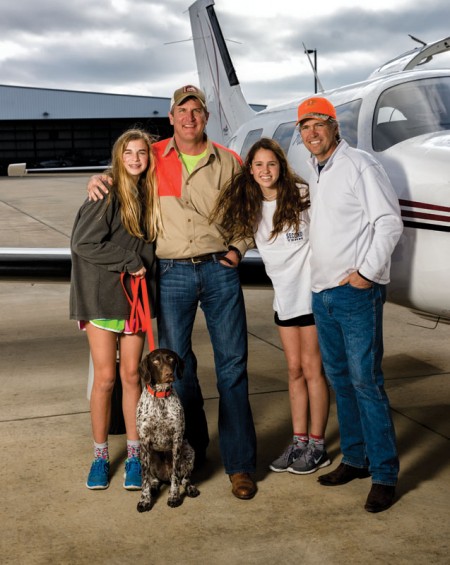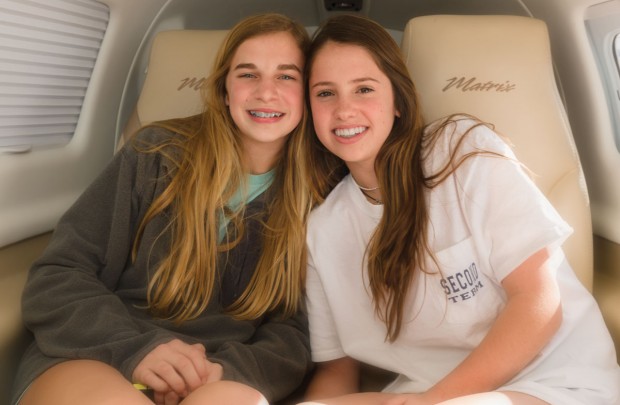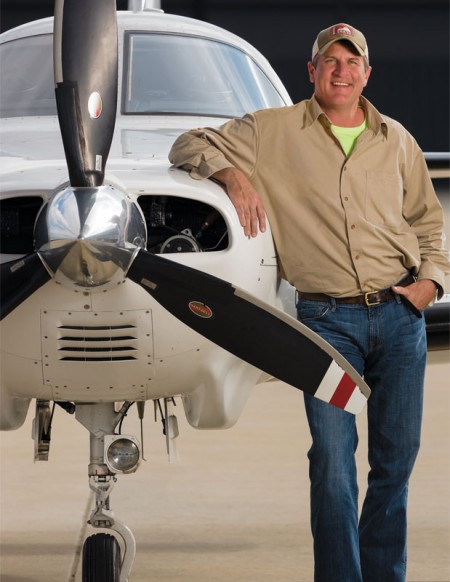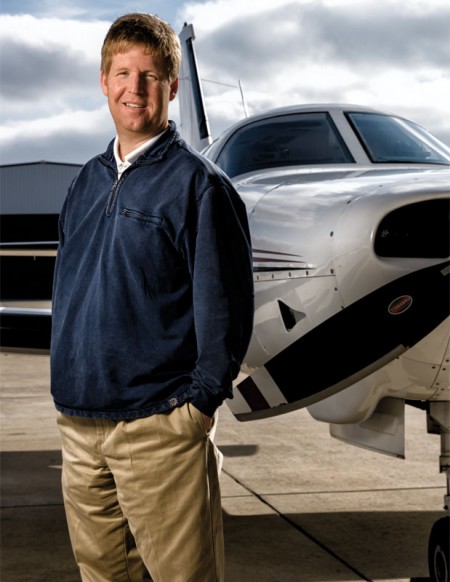Taking Flight


Carolyn Stewart, bird dog Leo, Colby Stewart, Remi Greenwood and Cameron Greenwood, from left, enjoyed a whirlwind quail-hunting trip. (Photo: www.hartphoto.com)
Who hasn’t wished for a private plane while standing in the TSA line, shoes and toiletries in hand?
Colby Stewart, a 48-year-old local ophthalmologist, knows the feeling well. Not only does he fly to Tennessee every month, but at 6-feet, 7-inches tall, he really feels the lack of legroom. “The airlines cram you in,” he said, “and then the flight will be late. It’s so frustrating.”
Stewart recently joined a group of friends, some who fly as a hobby and some, like Stewart, who want the convenience of their own plane, and bought a 6-seat Piper Matrix.
Ironically, Stewart doesn’t use the plane to go to Tennessee. There is no way around it: Flying in your own plane is always more expensive than flying commercially, when a commercial flight is available. And Stewart’s propeller plane would take twice as long, four hours, than a jet to make a trip of that distance. “At some point, you just say, ‘I’ll take the misery,’” said Stewart.
What a small private plane is good for is replacing long car trips. Stewart and his friend, Cameron Greenwood, recently took their two teenaged daughters, Carolyn and Remi, on a father-daughter quail-hunting trip. It would have taken them six hours to drive to the South Texas ranch where they hunted.
In their own plane, they took off minutes after arriving at the airport, since there’s no need to go through security. They rode in a cabin resembling a well-appointed SUV. And the foursome, along with pilot Don Sims, arrived at the ranch, landing on the ranch’s own landing strip, 1 hour and 20 minutes after leaving Houston. The entire overnight trip took a total of 24 hours, which would have been impossible without the plane.

Carolyn Stewart and Remi Greenwood, from left, had a fun weekend with their dads when they all flew to South Texas. (Photo: www.hartphoto.com)
Chris deZevallos, an avid pilot who grew up in Memorial, would rather take his daughters, 4-year-old twins Katharine and Sarah, in his plane than put them in the back of his car and drive them on Houston’s freeways.
“I used to ride motorcycles,” he said. “Statistically speaking, the biggest risk to a motorcyclist are the drivers around him. When you fly, the biggest risk is yourself. Planes are as safe as you make them.”
His wife, Shelly deZevallos, also a pilot, said they recently flew their girls to Sea World, a trip that took 1½ hours each way by plane, rather than 4 hours by car. “Planes are an incredible time-saving tool, for both business and family,” she said. “Plus, they are a joy to fly. My girls will look up and say, ‘Oh, we’re inside a cloud!’”
In a way, planes are like boats, vacation homes and horses: fun to own but also involved. For many plane owners, aviation becomes a central part of their lives. The deZevallos live in a “hangar home” at West Houston Airport. Shelly, whose family has owned the airport since 1971, is a third-generation pilot who was flying before she had her driver’s license. She and Chris met in a hangar at the airport. Chris had learned to fly when his work in real estate had him traveling to locations without good commercial air service.

Colby Stewart uses his plane to bring family and friends on quick, fun trips. (Photo: www.hartphoto.com)
This year, the family’s Christmas-card photo featured their plane, a Beechcraft Bonanza. And daughter Katharine spells her name the old-fashioned way, with an “a,” because she is named after Wilbur and Orville Wright’s sister, who was deeply involved in running their pioneering aviation business.
Steve Wright has been flying since 1967 and has owned his own plane since 1974. “I really wanted to be a commercial pilot,” he said. Instead, he taught people to fly while attending law school. Because of his plane, his family’s hobby has always been travel. Wright, who flew to Florida last month with his wife, Jan, said, “During their childhoods, we flew our kids to 45 of the 50 states, to Canada, to the Bahamas. Our family history is written in my log books.”
Private airplanes come in two main types: jets, whose engines create thrust, pushing the plane forward, and planes that use propellers. Turbo-props are in between: They use a jet-like engine to power their propellers.
Jets can travel farther and faster. Depending on the length of the trip, a jet can be twice as fast. However, they are much more expensive to buy and operate. Jet prices start at $1 million, with yearly maintenance costs of about $500,000. Some companies, such as Jet Linx, which runs its own terminal at Hobby Airport, and NetJets, seek to make private jet travel more convenient and (relatively) less expensive. Still, the cost is thousands of dollars per flight hour. Even Warren Buffett, whose company, Berkshire Hathaway, owns NetJets, finds the cost of a private jet hard to justify. According to a recent article in Forbes, Buffett named his own beloved jet “The Indefensible.”
Propeller planes range widely in price. A 2-seat, single-engine Cessna can go for as little as $10,000, while a brand-new, 6-seat, twin-engine Beechcraft Baron sells for $800,000.
Planes do not depreciate as quickly as cars and sometimes gain value. Steve Wright bought his first plane in 1974. “It cost $9,500, which was a lot of money back then,” he said. “I sold it for $12,500 five years later.” That plane is still flying – and is now worth $30,000.
That’s because planes are meticulously maintained. “Planes are basically kept, mechanically, in the same condition as when they rolled off the assembly line,” said Donald Sims, whose company, Sims Air, provides aircraft management, pilots and flight instruction.

After taking 12 years off when his children were small, Brady Crosswell decided to get back into flying. (Photo: www.hartphoto.com)
Learning to fly your plane is involved, so involved that Stewart, after taking about 20 hours of flying lessons 10 years ago, decided not to pursue it. “To be a really good pilot, you have to fly all the time,” he said. “I liked flying but didn’t think I would be able to devote enough time to it. I figured it’s better that I do what I do best – ophthalmology – and hire a pilot to do what he does best.”
Stewart’s not alone. Sims, a certified flight instructor, estimates that only about half the people who start flying lessons go on to get their private pilot’s license. That basic license is good for “visual flight rules” (VFR); basically, you can fly when you can see. To fly in less-than-perfect weather and through clouds, you need to have an instrument rating so you can fly under “instrument flight rules” (IFR); Sims estimates that fewer than 10 percent of all private pilots go on to get that rating. Pilots can also get “rated,” with additional training, to fly certain makes and models of airplane. Private pilots have to revalidate their licenses at least once every two years, taking a “check flight” with a certified flight instructor.
Brady Crosswell, a co-owner of Stewart’s plane, had gotten his license in 1988, then, in the early 2000s, stopped flying while his family and a company he had started were young.
Crosswell, who is instrument-rated, has undergone 25 hours of additional flight instruction over the last six months to regain currency and to become rated for his Piper Matrix.
Learning to fly is a bit of a psychological and emotional exercise. “Anyone can learn to fly, but some can’t get past the fear,” explained Chris deZevallos. “Everyone’s afraid at first, but you have to be able to push past that fear and fly the plane anyway.”
Learning to fly by the instruments adds another layer to that. When people can’t see while flying, they can become disoriented, a situation pilots call “the leans.” The pilot will feel as if the plane is turning, climbing, even flying upside-down when it is not. “People will swear they are hanging upside down against their seat restraints,” said Sims.
Sometimes, when teaching someone to rely on the plane’s instruments, a flight instructor will put a hood over the student’s head. Said Chris deZevallos, “You have to get to the point where you will go by ‘the six-pack,’ the six gauges in front of you, and ignore what your body is telling you.”
So, owning your own plane won’t allow you to always avoid flying commercially. (Boo.) But it is fun. And it can be convenient, especially when you travel to locations without good commercial service. But beware: It can also become an involved avocation. “It’s really a great hobby,” said Crosswell, “and a great escape.”
Want more buzz like this? Sign up for our Morning Buzz emails.
To leave a comment, please log in or create an account with The Buzz Magazines, Disqus, Facebook, or Twitter. Or you may post as a guest.


